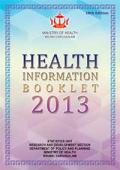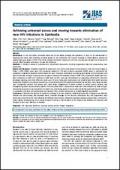What's New
Displaying results 3191 - 3200 of 4914

Resource | Publications,
The Global State of Harm Reduction 2014 maps the response to drug-related HIV, viral hepatitis and tuberculosis. It also integrates updated information on harm reduction services into each regional chapter, including on needle and syringe programmes (NSPs) and opioid substitution therapy (OST) provision; harm reduction services in the prison setting; access to antiretroviral therapy for people who inject drugs; regional overdose responses; policy developments; civil society developments; and information relating to funding for harm reduction.

Resource | Publications,
This report reflects the results of data for the calendar year 2013. For the first time since the 1990s, the number of new HIV infections among children in the 21 Global Plan priority countries in sub-Saharan Africa dropped to under 200 000 [170 000–230 000]. This represents a 43% decline in the number of new HIV infections among children in these 21 countries since 2009, providing reasons for optimism as the Global Plan pushes towards its 2015 goals of 90% reduction. However, there are also reasons for concern. Between 2012 and 2013 the pace of progress in reducing new HIV infections among children across the priority countries slowed substantially. While a number of countries made impressive gains, others stagnated or lost ground.
As the Global Plan makes the final push towards 2015, it is critical to consolidate the significant gains that have been made in many countries, to accelerate progress where results have stalled or reversed direction and to redouble our collective efforts towards the elimination of new HIV infections among children and keeping their mothers alive.

Resource | Publications,
The Ministry of Health through the Department of Policy and Planning is pleased to share the Health Information Booklet 2013 publication which marks the eighteenth edition.
The department continues to enhance efforts in ensuring the provision of accurate, timely and reliable health statistical information that serves as useful reference to policy makers, planners, healthcare providers, researchers and to the public at large. This is also in meeting the needs for monitoring of our health indicators which aligns with the Millennium Development Goals and in providing health data that are regularly reported to international organisations particularly the World Health Organisation (WHO).
This 2013 publication has incorporated additional information such as relating to Pharmacy Services, Maternal and Child Health Services, Hospital Specialist Services Attendances, and Age Standardised Mortality Rate of Noncommunicable Diseases.
The implementation of the Brunei Darussalam Healthcare Information Management System (Bru-HIMS) also contributes to enhancing the efficiency of data collection process and that health information can be easily and timely accessed, hence also improving the quality of health information publication in the future.

Resource | Publications,
The resident population of the Cook Islands was estimated at 14,974 in 2011(Cook Islands census 2011). There has been a population shift from the outer islands to the main population centres in Rarotonga and Aitutaki with 85% (13,097) living there. Life expectancy at birth is 72.8 years and it has an infant mortality rate of 6.8 deaths per 1,000 live births. The economy is largely dependent on tourism with a majority of tourists coming from New Zealand.
The NSP Working Group met from June 2012 to October 2013 and identified the following Priority Areas for the Cook Islands Integrated National Strategic Plan for Sexual and Reproductive Health. These priority areas are integrated with each other and not prioritised within themselves; each is as important as the others: leadership and policies, prevention and gender rights, program integration, comprehensive management of STIs and family planning, reproductive health and gender based violence.

Resource | Publications,
The Health Systems in Transition (HiT) profiles are country-based reports that provide a detailed description of a health system and of reform and policy initiatives in progress or under development in a specific country.
There are positive indications in Myanmar that, along with the changes in the political system and administrative structures following the 2010 national elections, the new government is undertaking reforms which include the health sector. Challenges remain for further improving health equity among its population.
Addressing health inequities is of paramount importance for Myanmar, needing a major reform that will ensure health care services reach the poor and the disadvantaged groups, in particular minority groups and in conflict-affected and hard-to-reach areas, through the effective functioning of township health system. From an equity perspective, the move towards primary health care concepts and practices is a step in the right direction.

Resource | Publications,
Situated in the heart of South East Asia, Cambodia is a low income country that is recovering from several decades of regional and internal conflict. Its population of 14.86 million is growing at a rate of 1.54% with 80% living in rural areas and 20% dwelling in cities. With a life expectancy of 57 years for men and 65 years for women, gross domestic product is [estimated at] 946 United States dollars per capita purchasing power parity.
In the mid-1990s, Cambodia faced one of the fastest growing HIV epidemics in Asia. For its achievement in reversing this trend, and achieving universal access to HIV treatment, the country received a United Nations millennium development goal award in 2010. This article reviews Cambodia’s response to HIV over the past two decades and discusses its current efforts towards elimination of new HIV infections.

Resource | Publications,
The National Strategic Plan (NSP) 2013-2017 is designed to guide Sri Lanka’s response to HIV/AIDS & STI control in the next five years and has been formulated with broad stakeholder involvement, drawing on the existing strengths and successes and the lessons learned in the last decade. It considers the policy and legal environment, the available scientific evidence, international best practices, and the estimated needs for prevention and treatment and current coverage rates and is informed, as best as possible, by resources that would be available. Linked to the strategic plan is a framework for monitoring and evaluation of progress and achievements.

Resource | Publications,
This issues brief is part of a series commissioned by The Global Coalition on Women and AIDS (GCWA). It is designed to bring to light critical issues pertaining to the SRHR of young women living with, at risk of and affected by HIV, along with examples of good practice interventions and successful scale-up approaches. It also examines how multiple dimensions of inequality create unique challenges for young women, and the subsequent impact on their health and rights. The brief is intended to guide global advocacy and inform negotiations in the context of the Post-2015 development framework. The brief concludes with seven recommendations to advance young women’s sexual and reproductive health (SRH) and to uphold their rights in the context of HIV.

Resource | Publications,
Advancements in HIV science mean that today people living with HIV (PLHIV) can work, study, play and participate in social activities without any impact on their productivity or interaction with others. HIV cannot be transmitted via skin-to-skin contact or through everyday social interaction. Antiretroviral (ARV) medicines to treat HIV are taken every day at the same time and received from doctors at regular intervals.
Yet, stigma and discrimination on basis of HIV status continue to persist not only in Malaysia, but also elsewhere.
As part of its European Union-funded Asia Action project, the Malaysian AIDS Council (MAC) has compiled a total of 17 discriminatory cases that were reported by PLHIV in 2013. These cases were reported to the MAC Policy Department who interacted with them directly to ensure accuracy of the accounts. Details were noted in a standardised form. When transmitted between MAC and government agencies, names and identification details were blacked out. Actions toward mitigation of each case were taken within two weeks of receipt.

Resource | Publications,
The Scan of Laws and Policies Affecting Human Rights, Discrimination and Access to HIV and Health Services by Key Populations in Pakistan identifies the current status of legislation, policies, institutional frameworks in Pakistan that safeguard the universal human rights of the key affected populations with regard to the HIV prevention, care and treatment. The scan establishes a baseline on the current enabling environment (law, policies and institutions) in relation to safeguarding the human rights of the key populations and second, and it provides a set of recommendations to input into any reforms to promote an enabling environment where the human rights of the key populations are protected.





